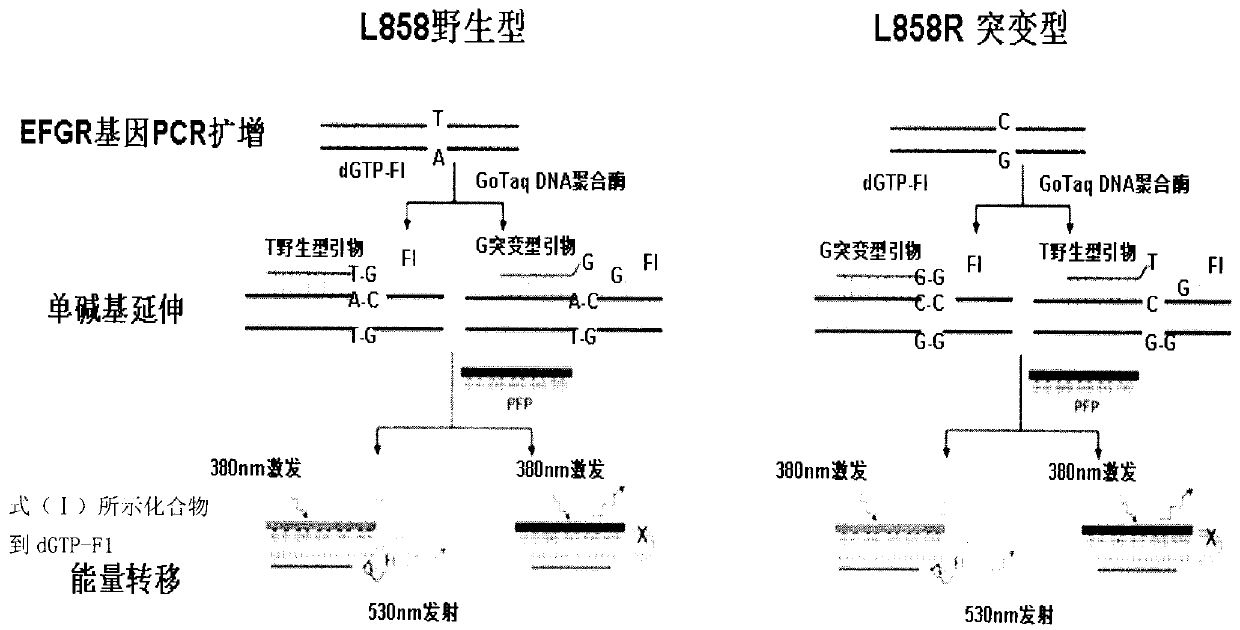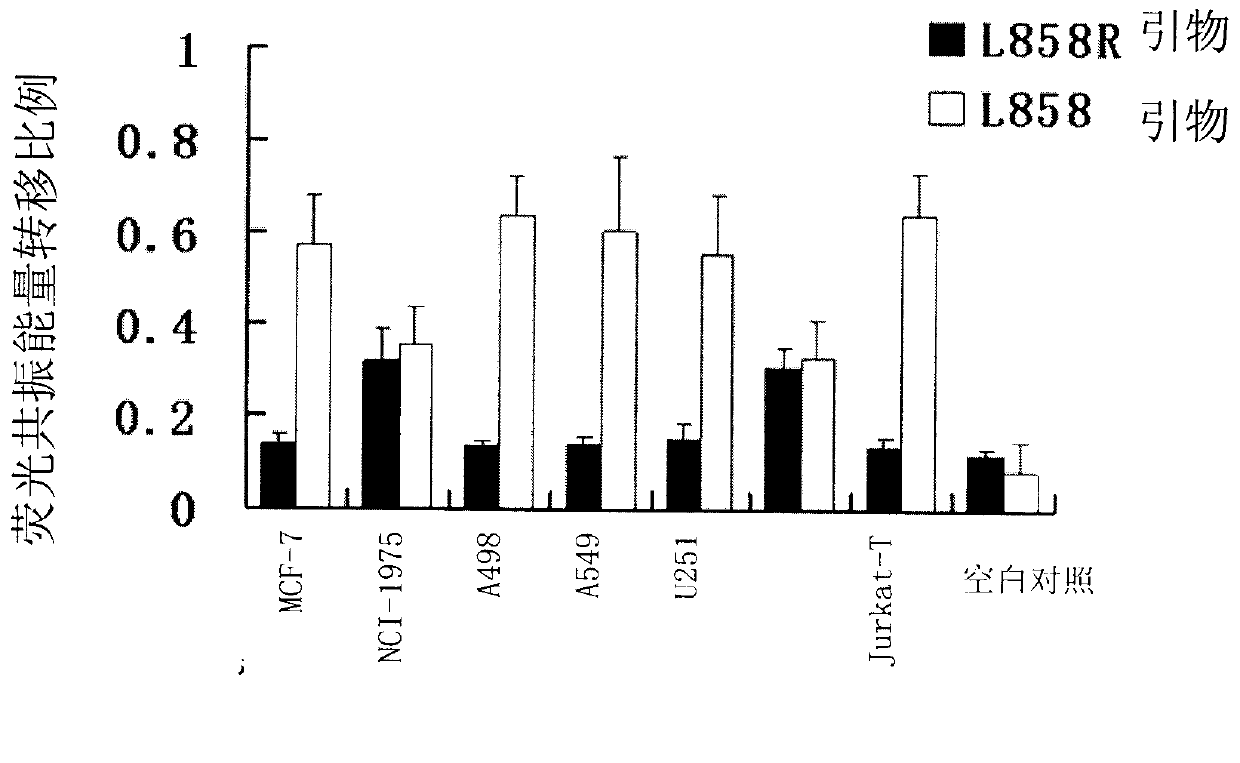Reagent for detecting EGFR genetic mutation and application thereof
A technology of reagents and genotypes, applied in the field of reagents for detecting EGFR gene mutations, can solve the problems of undetectable gene mutations, complex operations, and long cycles, and achieve the effects of fast processing, simple sample processing, and low cost
- Summary
- Abstract
- Description
- Claims
- Application Information
AI Technical Summary
Problems solved by technology
Method used
Image
Examples
Embodiment 1
[0036] Synthesis of compound shown in embodiment 1, formula (I)
[0037] 9,9-bis-(6'-bromohexyl)-2,7-dibromofluorene: purchased from Synwit Technology Co., Ltd, product number: 570414-33-4.
[0038] 2-Isopropoxy-4,4,5,5-tetramethyl-1,3,2-trioxaborane: purchased from Alfa Aesar Company, the product number is 999770-93-1.
[0039] The synthetic process of compound shown in formula (I) sees Figure 4 .
[0040] 1. Synthesis of 1,2-bis-(4-bromophenyl)-hydrazine
[0041] ① P-bromobenzoic acid (4.02g, 20mmol) is packed into a 25ml one-port bottle, and thionyl chloride (SO 2 Cl 2 , 3.63ml, 50mmol), then a catalytic amount of pyridine was added dropwise, the temperature was raised to 70°C, and stirred for 12h.
[0042] ② Step ① After the reaction is stopped, remove excess thionyl chloride by atmospheric pressure distillation, add dry N-methylpyrrolidone (NMP, 20ml), and add 10ml of dry NMP dissolved in hydrazine hydrate (0.5g, 10mmol) dropwise at room temperature, After the drop...
Embodiment 2
[0083]Embodiment 2, the composition of reagent
[0084] The reagent is composed of the compound represented by formula (I) prepared in Example 1, compound dGTP-F1, primer 1, primer 2, primer 3, primer 4, primer 5 and primer 6, and each component is packaged separately.
[0085] The compound dGTP-F1 is represented by formula (II), purchased from Perkin Elmer, and the product catalog number is: NEL429001EA.
[0086] Formula (II).
[0087] The sequences of the six primers are as follows, all synthesized by Shanghai Biotechnology Co., Ltd.:
[0088] Primer 1: 5'-TCAGCCTGGCAAGTCCAGTAAG-3';
[0089] Primer 2: 5'-AGCTCTGGCTCACACTACCAG-3';
[0090] Primer 3: 5'-CCTCACAGCAGGGTCTTCTC-3';
[0091] Primer 4: 5'-TGCCTCCTTCTGCATGGTA-3';
[0092] Primer 5: 5'-AGATCACAGATTTTGGGCT-3';
[0093] Primer 6: 5'-GATCACAGATTTTGGGCG-3'.
[0094] Primer 1, Primer 2, Primer 3 and Primer 4 were used to amplify the target gene (EFGR gene) by nested PCR, wherein Primer 1 and Primer 2 constituted t...
Embodiment 3
[0095] Embodiment 3, the reagent of application embodiment 2 detects A498 cell line (cancer cell line)
[0096] 1. Cultured cell lines
[0097] The A498 cell line was cultured in DMEM medium containing 10% fetal bovine serum at 37°C, 5% CO 2 ; Cells were collected when the cells covered 70% of the culture plate.
[0098] Two, the reagent of application embodiment 2 detects A498 cell line (cancer cell line)
[0099] 1. Extract the genomic DNA of the cells.
[0100] 2, with the genomic DNA of step 1 as template, carry out PCR amplification with the primer pair that primer 1 and primer 2 form, PCR amplification product carries out agarose gel electrophoresis (see figure 2 ), to obtain a PCR amplification product of 659bp.
[0101] 3, with the PCR amplification product of step 2 as template, carry out PCR amplification with the primer pair that primer 3 and primer 4 are formed, PCR amplification product carries out agarose gel electrophoresis (see figure 2 ), to obtain a PC...
PUM
 Login to View More
Login to View More Abstract
Description
Claims
Application Information
 Login to View More
Login to View More - R&D
- Intellectual Property
- Life Sciences
- Materials
- Tech Scout
- Unparalleled Data Quality
- Higher Quality Content
- 60% Fewer Hallucinations
Browse by: Latest US Patents, China's latest patents, Technical Efficacy Thesaurus, Application Domain, Technology Topic, Popular Technical Reports.
© 2025 PatSnap. All rights reserved.Legal|Privacy policy|Modern Slavery Act Transparency Statement|Sitemap|About US| Contact US: help@patsnap.com



